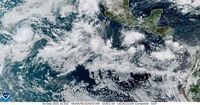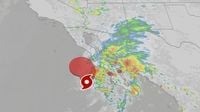A pair of powerful tropical systems—Hurricane Kiko and Tropical Storm Lorena—have captured the attention of meteorologists and residents across the Pacific, threatening to bring heavy rain, dangerous surf, and flash flooding to parts of Mexico, Hawaii, and the southwestern United States in early September 2025.
According to the National Hurricane Center (NHC), Hurricane Kiko intensified into a formidable Category 4 storm on Wednesday, September 3, with maximum sustained winds reaching 130 miles per hour as of Thursday afternoon. Though still more than 1,000 miles from Honolulu, Kiko’s trajectory has forecasters keeping a close eye on the Hawaiian Islands for potential impacts early to mid next week. While it’s too soon to say if the hurricane will make landfall, the storm’s power and unpredictability have prompted experts to warn of significant wind and rain—even if Kiko weakens before arrival.
“If Kiko continues toward Hawaii, even as a less intense tropical storm, it could still bring significant wind and rain to the islands next week,” AccuWeather hurricane expert Alex DaSilva told reporters. Meteorologist Tyler Roys, also with AccuWeather, projected that the eastern and northern Big Island and northern Maui could see four to eight inches of rainfall from mid-to-late next week, potentially triggering flash flooding or mudslides.
But while Kiko churns far offshore, another system—Tropical Storm Lorena—has already begun to lash Mexico’s Pacific coast and Baja California Peninsula with heavy rain, strong winds, and hazardous ocean conditions. Lorena, which briefly reached hurricane strength before being downgraded on Thursday, September 4, has proven unpredictable and dangerous in its own right.
As of Thursday, Lorena’s maximum sustained winds were measured at 60 mph, and the storm was meandering roughly 100 miles off the western coast of Mexico’s Baja Peninsula, according to weather.com and the NHC. The core of the storm remained offshore, but outer rainbands soaked areas around Los Cabos with two to nine inches of rain, raising the risk of life-threatening flash floods and mudslides, especially in higher terrain. The NHC warned, “This will bring the risk of life-threatening flash floods and mudslides, especially in areas of higher terrain.”
Rainfall totals for Baja California Sur, far southeast Baja California, and southwestern Sonora could reach as high as 15 inches through Friday, September 5, with up to six inches expected for the rest of Sonora and northern Sinaloa. The Mexican government issued storm warnings and watches for Baja California Sur, which includes major tourist destinations like Los Cabos. The national water commission, Conagua, urged residents to take extreme precautions in affected areas.
“A Tropical Storm Warning is in effect for...West Coast of Baja California Sur from Puerto Cortés to Punta Eugenia. A Tropical Storm Warning means that tropical storm conditions are expected somewhere within the warning area. Interests elsewhere on the Baja California peninsula and in northwestern Mexico should monitor the progress of Lorena,” the NHC stated in a public advisory.
Lorena’s path has been closely monitored, with predictions that it would move parallel to Baja California through Thursday night before approaching the coast on Friday. The NHC expected the storm to weaken into a post-tropical depression by Friday night. Despite the expiration of all tropical storm warnings across northwestern Mexico by September 4, heavy rainfall has persisted, with flooding threats continuing into the weekend.
Jennifer Gray, a weather and climate writer for weather.com, noted that the rainfall outlook for the American Southwest was initially more promising. Some moisture from Lorena was expected to spread northeastward into the U.S., with flood watches issued for southeastern California and southern Arizona for the weekend. Up to an inch of rain was possible in higher elevations of southern and central Arizona, but the rainfall was not expected to be widespread. “For our area down here in Southern Arizona, we are correlating this influx of moisture as an indirect cause of the [tropical storm]. The [tropical storm's] general push northwards helped push more moisture into our area,” National Weather Service meteorologist Kiera Malarkey told Newsweek.
Despite the limited rainfall expected, the region could have used much more. As of August 28, 2025, the entire state of Arizona was experiencing drought conditions, and 70% of New Mexico was suffering from drought. Monsoonal rains, which typically provide relief, have been behind schedule in the Desert Southwest, compounding the dryness. The prospect of widespread, drought-denting rain faded as Lorena curved away from the U.S., leaving only isolated pockets of precipitation in its wake.
Still, the threat of flash flooding lingered—not only in Arizona and New Mexico, but also in parts of Texas, where Lorena’s moisture could combine with a slow-moving frontal boundary to produce locally flooding rain over the weekend. The NHC also cautioned about life-threatening surf and rip current conditions, with waves up to 12 feet reported offshore of Baja California.
Lorena’s rapid intensification and subsequent weakening mirrored the volatility that often characterizes Eastern Pacific hurricane seasons. The storm became the 12th named system of the season, which runs from May 15 through November 30—beginning two weeks earlier than the Atlantic and Central Pacific seasons. On Wednesday, September 3, Lorena intensified into a Category 1 hurricane with maximum sustained winds of 75 mph, located 105 miles off Cabo San Lucas, before beginning to lose strength as it moved northwards at 24 kph (about 15 mph).
Throughout the ordeal, Mexican authorities remained vigilant. The national water commission, Conagua, repeatedly urged residents to heed warnings, especially those in vulnerable coastal and mountainous regions. Satellite images from the U.S. National Hurricane Center and Colorado State University’s Cooperative Institute for Research in the Atmosphere (CSU/CIRA) showed Lorena’s swirling mass off the coast of Mexico near the Gulf of California—an ominous reminder of the storm’s potential.
As the weekend approached, the focus shifted back to Hurricane Kiko and its uncertain path toward Hawaii. While no watches or warnings had yet been issued for the islands, the possibility of significant wind, rain, and flooding loomed large. Meteorologists cautioned that even a weakened Kiko could bring disruptive weather, urging residents and officials to stay alert as forecasts evolved.
In a season already marked by extreme weather and persistent drought, the twin threats of Kiko and Lorena have underscored just how quickly conditions can change—and how communities across the Pacific and the American Southwest must remain prepared for whatever nature throws their way.

